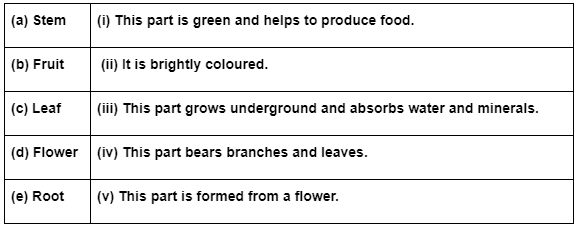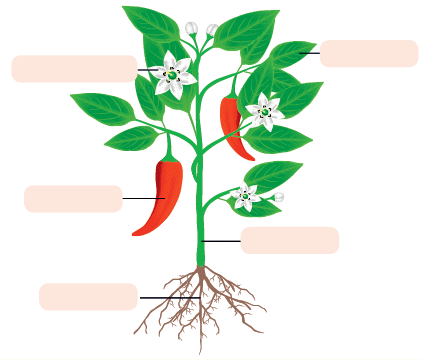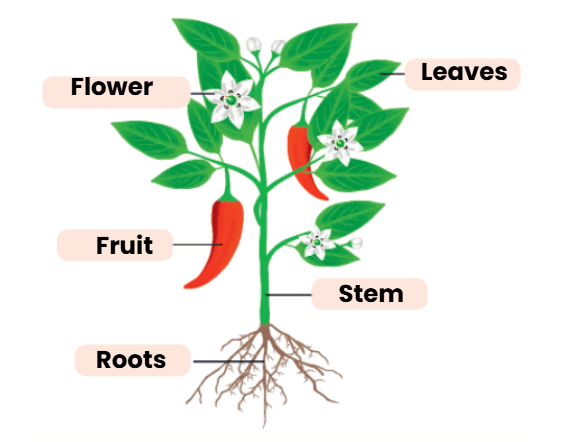Class 3 Science - Parts of a Plant - CBSE Worksheets Solutions
Q1. Name the following:
a) The part of the plant that grows underground.
Ans: Root
b) The green part of the plant that makes food.
Ans: Leaf
c) The process by which plants prepare food using sunlight.
Ans: Photosynthesis
d) The part of a plant that contains seeds.
Ans: Fruit
e) The type of root found in mustard plants.
Ans: Taproot
Q2: Choose the correct option.
a) Which part of the plant transports water and nutrients?
(a) Leaf
(b) Root
(c) Stem
(d) Fruit
Ans: (c) Stem
The stem carries water and food from the roots to different parts of the plant.
b) Which of the following plants has a fibrous root system?
(a) Mango
(b) Wheat
(c) Carrot
(d) Pea
Ans: (b) Wheat
Fibrous roots are thin and spread out. Wheat has this type of root.
c) All of these are leaves that store food, except
(a) cabbage
(b) broccoli
(c) spinach
(d) lettuce
Ans: (b) broccoli
Cabbage, spinach, and lettuce store food in their leaves, but broccoli does not.
d) Which of these plants has a fibrous root system?
(a) Radish
(b) Onion
(c) Carrot
(d) Bean
Ans: (b) Onion
Onion has thin, branched roots, which are called fibrous roots.
e) These are woody plants with thick and strong stems.
(a) Trees
(b) Climbers
(c) Shrubs
(d) Creepers
Ans: (a) Trees
Trees have strong, woody stems called trunks.
Q3. Fill in the blanks.
a) The flat green part of a leaf is called the ______.
Ans: The flat green part of a leaf is called the Leaf blade.
b) Plants need sunlight, ______, and water for photosynthesis.
Ans: Plants need sunlight, Carbon dioxide and water for photosynthesis.
c) The ______ of a plant contains seeds.
Ans: The fruit of a plant contains seeds.
d) ______ plants have weak stems and grow along the ground.
Ans: Creeper plants have weak stems and grow along the ground.
e) The stem carries ______ and ______ to different parts of the plant.
Ans: The stem carries water and nutrients to different parts of the plant.
Q4. True & False
a) A single thick root with many branches is a taproot.
Ans: True
b) Leaf is known as the kitchen of the plant.
Ans: True
c) All fruits have only one seed.
Ans: False
Some fruits like papaya have many seeds.
d) Fruit is not a part of the shoot.
Ans: False
Fruits grow from flowers, which are part of the shoot system.
e) Tiny tubes present in the leaf are called stomata.
Ans: True
Q5. Match the following

Ans:

Q6. Short Answer Question
a) What is the difference between taproot and fibrous roots?
Ans: Taproots grow deep into the soil and have one thick main root.
Fibrous roots are thin and spread out in all directions.
b) What functions does a stem have? What are stomata?
Ans: Functions of the stem: It carries water and food to different parts of the plant and holds the plant upright.
Stomata: Tiny openings on the leaf that help in breathing and water loss.
c) Where is the food made by plants stored?
Ans: Plants store food in leaves, stems, and roots. For example, potato stores food in its stem, while carrot stores food in its root.
d) List some of the functions of the root.
Ans: (i) Roots absorb water and minerals from the soil.
(ii) They hold the plant firmly in the ground.
(iii) Some roots store food.
e) Name the components required by leaves for making food.
Ans: Leaves need sunlight, carbon dioxide, water, and chlorophyll to make food through photosynthesis.
Q7. Draw and label
Label the following parts of a plant. Draw a similar picture in your notebook.

Ans:
|
20 videos|121 docs|32 tests
|
FAQs on Class 3 Science - Parts of a Plant - CBSE Worksheets Solutions
| 1. What are the main parts of a plant? |  |
| 2. What is the role of the roots in a plant? |  |
| 3. How do leaves help a plant? |  |
| 4. What is the function of the stem in a plant? |  |
| 5. Why are flowers important to plants? |  |

















